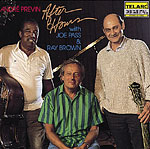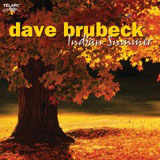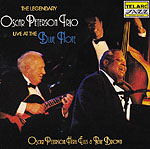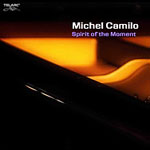Home » Jazz Articles » Record Label Profile » Telarc Records
Telarc Records
We look at our artists as partners," says Wilpizeski. "It's not like, 'We're going to do the work, you go out there and play the concert.' They have to do more than that these days.
—Mike Wilpizeski
 Telarc, established by Jack Renner and Robert Woods in 1977 in Cleveland, Ohio began as a classical music label, later branching into jazz with the 1989 release of Andre Previn's After Hours and eventually adding blues to its docket in 1993. In 2005, the company was annexed by Concord Music Group, while retaining its distinctive identity and reputation for audio excellence.
Telarc, established by Jack Renner and Robert Woods in 1977 in Cleveland, Ohio began as a classical music label, later branching into jazz with the 1989 release of Andre Previn's After Hours and eventually adding blues to its docket in 1993. In 2005, the company was annexed by Concord Music Group, while retaining its distinctive identity and reputation for audio excellence.Telarc's central mission is to create outstanding recorded performances using the highest fidelity on its naturalistic recordings; its prominent calling card is acoustical perfectionism, manifested through craftsmanship and progressive technology. The craftsmanship is a result of long experience, attention to detail and a "less-is-best" philosophy towards mic-ing, mixing and related production values. Cultivating a guild-like family atmosphere, Renner and Woods have honed their expertise within a close circle of collaborators, particularly ace engineers Michael Bishop and Robert Friedrich. Pioneering technology has also played a key role. In 1978, it was first to cut direct-to-disc LPs; the same year it was first in the US to release commercial classical music in digital format; in 1983 Telarc co-inaugurated compact discs; in 1988 it introduced audiophiles to 20-bit sampling (made possible by an innovative proprietary analog-to-digital converter) and in 1996 expanded commercial sampling rates to 24-bits.
 Elaine Martone, Executive VP of Production, a 27-year veteran and top-shelf classical/jazz producer, observed: "Our musicians always comment on the great sound quality... It's one of the things we're known for and we take a lot of time and care... We bring in piano techs and our own gear—all of that takes more time and more money—but it's one of the things that we just do as a matter of course." Pianist/composer Michel Camilo confirms: "They really care about getting the best possible sound you can ever get. So there's a lot of effort involved in that and a lot of attention to detail...and when you go to the studio and you see all this stuff they bring into the studio to record, the extra gear, it's pretty impressive." Telarc offers Super Audio (SACD) and 5.1 DTS Surround multi-track CDs in continued efforts to satisfy the most discerning ears. Hi-res downloads, asserts Jason Linder, VP of Marketing, are "just down the pike."
Elaine Martone, Executive VP of Production, a 27-year veteran and top-shelf classical/jazz producer, observed: "Our musicians always comment on the great sound quality... It's one of the things we're known for and we take a lot of time and care... We bring in piano techs and our own gear—all of that takes more time and more money—but it's one of the things that we just do as a matter of course." Pianist/composer Michel Camilo confirms: "They really care about getting the best possible sound you can ever get. So there's a lot of effort involved in that and a lot of attention to detail...and when you go to the studio and you see all this stuff they bring into the studio to record, the extra gear, it's pretty impressive." Telarc offers Super Audio (SACD) and 5.1 DTS Surround multi-track CDs in continued efforts to satisfy the most discerning ears. Hi-res downloads, asserts Jason Linder, VP of Marketing, are "just down the pike." Telarc established itself as a preeminent jazz label through releases by Dave Brubeck, Ahmad Jamal, Oscar Peterson and Ray Brown, among others. After Previn's date, Ray Brown approached them to record his trio with Peterson and Herb Ellis live at Blue Note. Telarc's palette expanded in the next two decades to include crooners John Pizzarelli and Tony DeSare, chanteuses Tierney Sutton and Ann Hampton Callaway and up-and-comer Melissa Morgan, Latinos Arturo Sandoval and Michel Camilo, the classically-rooted jazz string quartet Turtle Island String Quartet, fusionist's Hiromi and Al Di Meola and 'mainstream' eclectics Benny Green, Monty Alexander, Geri Allen and Saxophone Summit. Acts like Hiromi have attracted a younger demographic into Telarc's fold, fans more likely to whet their musical whistles in the digital realm via MySpace, artist webpages, iTunes, eMusic, blogs and podcasts. Telarc has even recorded two live albums at Starbucks, bringing jazz to the java generation. Online accessibility is immense, Linder notes, but as more people surf for new sounds, decreasingly reliant on traditional media (magazine reviews, retail stores), it increases pressure on indie labels "to be everywhere, all the time."
Telarc established itself as a preeminent jazz label through releases by Dave Brubeck, Ahmad Jamal, Oscar Peterson and Ray Brown, among others. After Previn's date, Ray Brown approached them to record his trio with Peterson and Herb Ellis live at Blue Note. Telarc's palette expanded in the next two decades to include crooners John Pizzarelli and Tony DeSare, chanteuses Tierney Sutton and Ann Hampton Callaway and up-and-comer Melissa Morgan, Latinos Arturo Sandoval and Michel Camilo, the classically-rooted jazz string quartet Turtle Island String Quartet, fusionist's Hiromi and Al Di Meola and 'mainstream' eclectics Benny Green, Monty Alexander, Geri Allen and Saxophone Summit. Acts like Hiromi have attracted a younger demographic into Telarc's fold, fans more likely to whet their musical whistles in the digital realm via MySpace, artist webpages, iTunes, eMusic, blogs and podcasts. Telarc has even recorded two live albums at Starbucks, bringing jazz to the java generation. Online accessibility is immense, Linder notes, but as more people surf for new sounds, decreasingly reliant on traditional media (magazine reviews, retail stores), it increases pressure on indie labels "to be everywhere, all the time."New York based publicist Mike Wilpizeski is Telarc's liaison to the many artists and industry professionals who live in or pass through the jazz hub.
 He praises the "down-to-earth," artist-friendly nature of his company: "They're very straight-up with their artists...which is refreshing." He contrasts this with the "bottom-line, bean-counting, quarter-to-quarter" mentality of his former major label employers, which created tense working conditions and rapid employee turnover. Telarc, by comparison, is downright cozy: "I've been there ten years and I'm one of the new guys...Bob [Woods, president] knows all of us...so it's family oriented."
He praises the "down-to-earth," artist-friendly nature of his company: "They're very straight-up with their artists...which is refreshing." He contrasts this with the "bottom-line, bean-counting, quarter-to-quarter" mentality of his former major label employers, which created tense working conditions and rapid employee turnover. Telarc, by comparison, is downright cozy: "I've been there ten years and I'm one of the new guys...Bob [Woods, president] knows all of us...so it's family oriented."Martone emphasizes the collaborative nature of label-artist relations. "There's the good and the bad part of this: we don't have a pop or a rock division that supports our classical and jazz—we are allowed to do what we do. That's the good part. The bad part is it's a hard thing to find a creative way to artistic fulfillment and turning a profit. The beauty of it is that we're all working as a team... We look at how much is it going to cost, how much do we think it can sell and we're very conservative about that. You have to be when record retail is in the state it's in." Interestingly, while artists once toured to foster record sales, today CD releases function primarily as merchandise to promote bookings, so artists and labels must cooperate for mutual survival. "We look at our artists as partners," says Wilpizeski. "It's not like, 'We're going to do the work, you go out there and play the concert.' They have to do more than that these days."
 In spite of sagging sales, Telarc musicians enjoy artistic autonomy. "They always give me a full freedom on what I would like to do in the album making, with love and respect," writes Hiromi. "They really care for artists and I am very grateful to have that." Camilo is similarly satisfied: "I could be the producer of my own recordings and I could pick and choose whatever I wanted to do, mainly." Martone remains optimistic: "The business as we know doesn't resemble the business of five years ago, which wasn't the way the business was ten years ago. I have lived through four major downturns in the industry. How much further down can it go? Still, the question that I always like to ask is, 'In the face of this, now what? What can we create? Because even in all these challenges, there's still opportunity. You always have to look for the opportunity and never settle for less than excellence."
In spite of sagging sales, Telarc musicians enjoy artistic autonomy. "They always give me a full freedom on what I would like to do in the album making, with love and respect," writes Hiromi. "They really care for artists and I am very grateful to have that." Camilo is similarly satisfied: "I could be the producer of my own recordings and I could pick and choose whatever I wanted to do, mainly." Martone remains optimistic: "The business as we know doesn't resemble the business of five years ago, which wasn't the way the business was ten years ago. I have lived through four major downturns in the industry. How much further down can it go? Still, the question that I always like to ask is, 'In the face of this, now what? What can we create? Because even in all these challenges, there's still opportunity. You always have to look for the opportunity and never settle for less than excellence."
< Previous
DodoVoodoo
Next >
Al Dente
Comments
Tags
For the Love of Jazz
 All About Jazz has been a pillar of jazz since 1995, championing it as an art form and, more importantly, supporting the musicians who create it. Our enduring commitment has made "AAJ" one of the most culturally important websites of its kind, read by hundreds of thousands of fans, musicians and industry figures every month.
All About Jazz has been a pillar of jazz since 1995, championing it as an art form and, more importantly, supporting the musicians who create it. Our enduring commitment has made "AAJ" one of the most culturally important websites of its kind, read by hundreds of thousands of fans, musicians and industry figures every month.























